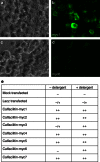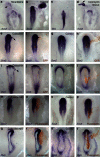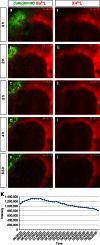Calfacilitin is a calcium channel modulator essential for initiation of neural plate development
- PMID: 23673622
- PMCID: PMC3674269
- DOI: 10.1038/ncomms2864
Calfacilitin is a calcium channel modulator essential for initiation of neural plate development
Abstract
Calcium fluxes have been implicated in the specification of the vertebrate embryonic nervous system for some time, but how these fluxes are regulated and how they relate to the rest of the neural induction cascade is unknown. Here we describe Calfacilitin, a transmembrane calcium channel facilitator that increases calcium flux by generating a larger window current and slowing inactivation of the L-type CaV1.2 channel. Calfacilitin binds to this channel and is co-expressed with it in the embryo. Regulation of intracellular calcium by Calfacilitin is required for expression of the neural plate specifiers Geminin and Sox2 and for neural plate formation. Loss-of-function of Calfacilitin can be rescued by ionomycin, which increases intracellular calcium. Our results elucidate the role of calcium fluxes in early neural development and uncover a new factor in the modulation of calcium signalling.
Figures








Similar articles
-
The Pou5f1/Pou3f-dependent but SoxB-independent regulation of conserved enhancer N2 initiates Sox2 expression during epiblast to neural plate stages in vertebrates.Dev Biol. 2011 Apr 15;352(2):354-66. doi: 10.1016/j.ydbio.2010.12.027. Epub 2010 Dec 23. Dev Biol. 2011. PMID: 21185279
-
Wnt-regulated temporal control of BMP exposure directs the choice between neural plate border and epidermal fate.Development. 2009 Jan;136(1):73-83. doi: 10.1242/dev.025890. Development. 2009. PMID: 19060333
-
A mechanism regulating the onset of Sox2 expression in the embryonic neural plate.PLoS Biol. 2008 Jan;6(1):e2. doi: 10.1371/journal.pbio.0060002. PLoS Biol. 2008. PMID: 18184035 Free PMC article.
-
Integration of anterior neural plate patterning and morphogenesis by the Wnt signaling pathway.Dev Neurobiol. 2014 Aug;74(8):759-71. doi: 10.1002/dneu.22135. Epub 2013 Nov 4. Dev Neurobiol. 2014. PMID: 24115566 Review.
-
The choice between epidermal and neural fate: a matter of calcium.Int J Dev Biol. 2004;48(2-3):75-84. doi: 10.1387/ijdb.15272372. Int J Dev Biol. 2004. PMID: 15272372 Review.
Cited by
-
Trpc1 as the Missing Link Between the Bmp and Ca2+ Signalling Pathways During Neural Specification in Amphibians.Sci Rep. 2019 Nov 5;9(1):16049. doi: 10.1038/s41598-019-52556-0. Sci Rep. 2019. PMID: 31690785 Free PMC article.
-
Exploring the roles of FGF/MAPK and cVG1/GDF signalling on mesendoderm induction and convergent extension during chick primitive streak formation.Dev Genes Evol. 2022 Dec;232(5-6):115-123. doi: 10.1007/s00427-022-00696-1. Epub 2022 Sep 23. Dev Genes Evol. 2022. PMID: 36149507 Free PMC article.
-
A gene regulatory network for neural induction.Elife. 2023 Mar 3;12:e73189. doi: 10.7554/eLife.73189. Elife. 2023. PMID: 36867045 Free PMC article.
-
'Neighbourhood watch' model: embryonic epiblast cells assess positional information in relation to their neighbours.Development. 2022 May 15;149(10):dev200295. doi: 10.1242/dev.200295. Epub 2022 May 16. Development. 2022. PMID: 35438131 Free PMC article.
-
The role of voltage-gated calcium channels in neurotransmitter phenotype specification: Coexpression and functional analysis in Xenopus laevis.J Comp Neurol. 2014 Aug 1;522(11):2518-31. doi: 10.1002/cne.23547. Epub 2014 Apr 12. J Comp Neurol. 2014. PMID: 24477801 Free PMC article.
References
-
- Harland R., Gerhart J. Formation and function of Spemann's organizer. Annu. Rev. Cell Dev. Biol. 13, 611–667 (1997). - PubMed
-
- Nakamura O., Toivonen S. (eds). in Organizer: a Milestone of a Half-century from Spemann Elsevier/North Holland: Amsterdam, (1978).
-
- Spemann H., Mangold H. Über Induktion von Embryonalanlagen durch Implantation artfremder Organisatoren. Roux’ Arch. EntwMech. Org. 100, 599–638 (1924).
-
- Storey K. G., Crossley J. M., De Robertis E. M., Norris W. E., Stern C. D. Neural induction and regionalisation in the chick embryo. Development 114, 729–741 (1992). - PubMed
-
- Gallera J. Primary induction in birds. Adv. Morph. 9, 149–180 (1971). - PubMed
Publication types
MeSH terms
Substances
Associated data
- Actions
Grants and funding
LinkOut - more resources
Full Text Sources
Other Literature Sources
Molecular Biology Databases
Research Materials

